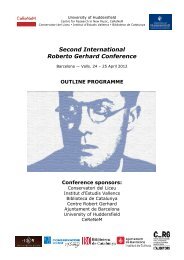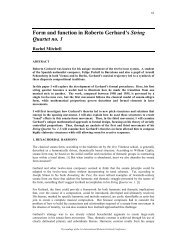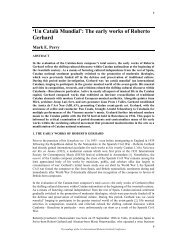the electronic music - Roberto Gerhard
the electronic music - Roberto Gerhard
the electronic music - Roberto Gerhard
Create successful ePaper yourself
Turn your PDF publications into a flip-book with our unique Google optimized e-Paper software.
[33] This was <strong>the</strong> case in Stratford’s play Pericles (1958): [Tape.01-1.254] credits “Studio Black, Queens<br />
Way” for <strong>the</strong> recording of a set of percussion and exotic instruments.<br />
[34] “Tinc un prec que t’agrairia d’alló més, si tens tamps, que em poguessis complaure am la possible<br />
urgéncia: em podries fer un troç de cinta magnetofónica enregistrant el so de dos parells de<br />
‘castañuelas’, l’un el més agut possible i l’altre el més baix possible.” Letter from <strong>Gerhard</strong> to Joaquim<br />
Homs, 27 th June 1959. [<strong>Gerhard</strong>.14.192]<br />
[35] “[...] a friend of ours brought home from Australia a recording of fishes. And I told <strong>Roberto</strong> about it.<br />
And he said, bring me that recording, get me that recording. Borrow it. So I did. And he put it into a<br />
rythmical skeleton.” According to Poldi <strong>Gerhard</strong> in [Gavin 1971]<br />
[36] “The microphone captures <strong>the</strong> living spark of <strong>the</strong> natural acoustic source; sound is thus taken fullyfashioned<br />
with its intrinsic harmonic structure, its attack, its main characteristics of body and decay<br />
and also with <strong>the</strong> noise-content inseparable from all of it, all complete. Personally I feel that this, as it<br />
were, naturally animated material is preferable to <strong>the</strong> syn<strong>the</strong>tic <strong>electronic</strong> sound, built up from sinetone<br />
with it’s lifeless signal quality.” [<strong>Gerhard</strong> 1959: 34] (Concrete <strong>music</strong> and <strong>electronic</strong> sound<br />
composition)<br />
[37] 2 FREQUENCY OSCILLATORS at lowest possible frequency, ½ tone or less apart. [<strong>Gerhard</strong>.7.102]<br />
[38] I did not examine any loose splices in case <strong>the</strong>y would break during <strong>the</strong> sorting of <strong>the</strong> tapes.<br />
[39] Were not catalogued<br />
[40] This is what <strong>Gerhard</strong> called his <strong>the</strong>ory of change of family through sound mutation. [Sound<br />
Observed].<br />
[41] “Sonderheft über Elektronische Musik” Technische Hausmitteilungen des Nordwestdeutschen<br />
Rundfunks. Jahrgang 6 Nr.1-2 (1954).<br />
[42] À la recherche d’une musique concrète. E. Du Seuil (1952) Gravesaner Blätter Perspectives of New<br />
Music Vol 1, No 1 (1962) Stockhausen, K: The concept of unity in <strong>electronic</strong> Music in Babbit, Milton:<br />
“Twelve-Tone Rythmic Structure and <strong>the</strong> Electronic medium”<br />
[43] [Cholij 1995, p 30]<br />
[44] <strong>Gerhard</strong> always wrote 7” instead of 7” ½ in his sound score [<strong>Gerhard</strong>.7.102].<br />
[45] Ibid. f 9r<br />
[46] Ibid. f 4v<br />
[47] Hence <strong>the</strong> name ‘pan cues’ stage managers used to give to <strong>the</strong> sound cues. My Fair Lady, transferred<br />
from Broadway to <strong>the</strong> Theatre Royal in 1957, stands as a reference for <strong>the</strong> introduction magnetic tape<br />
for this purpose. Stanton, Sarah and Banham, Martin: "The Cambridge Paperback Guide to Theatre".<br />
Cambridge University Press, Cambridge 1996. (p. 347)<br />
[48] <strong>Gerhard</strong>’s <strong>music</strong> for Stratford’s Shakespeare Productions has been treated in detail in Cholij, Irena:<br />
"<strong>Roberto</strong> <strong>Gerhard</strong>'s Music for Stratford Shakespeare Productions 1947-1962 and its context".<br />
Unpublished MA dissertation, University of Birmingham 1995. About <strong>the</strong> controversy with <strong>the</strong><br />
Musicians see Cholij, op. cit., pp. 7-9.<br />
[49] All of <strong>the</strong> <strong>the</strong>ater plays in [Davies 1981] catalogue are represented in <strong>the</strong> tape collection. On <strong>the</strong> o<strong>the</strong>r<br />
hand, apart from <strong>the</strong> annotations on an empty box which could have contained a recording of <strong>the</strong><br />
panatropes of Cymbeline (1949) [Tape 01.1-140], I did not identify any tapes corresponding to Romeo<br />
and Juliet (1947), The Taming of <strong>the</strong> Shrew (1953/54) or A Midsummer Night’s Dream (1954), none<br />
of which are counted among his <strong>electronic</strong> works.<br />
[50] [Davies 1968 & 1981]. The use of manipulated tape was already noted in [Drew 1956].<br />
[51] [Tape.01.1-248] I have provided <strong>the</strong> list of tapes related to each of <strong>the</strong> compositions as a footnote to<br />
<strong>the</strong> title. In this case I only found a single tape that makes reference to The Prisoner.<br />
[52] [<strong>Gerhard</strong>.14.41, <strong>Gerhard</strong>.14.54]<br />
[53] Toge<strong>the</strong>r with a transcription of <strong>the</strong> <strong>the</strong>atre programme which credits <strong>Gerhard</strong> for <strong>the</strong> <strong>music</strong> of a<br />
performance dated 3 May 1954. Theatre collections: Programme collection. Templemann Library.<br />
University of Kent at Canterbury.<br />
http://library.kent.ac.uk/library/special/Programmes/PRG1954.HTM (Last retrieved<br />
14.04.2010).<br />
[54] [Tape.01.1-44, Tape.01.1-45, Tape.01.1-97, Tape.01.1-130, Tape.01.1-135 and Tape.01.1-491].<br />
[55] Thanks to [Cholij 1996] and <strong>the</strong> wide range of available sources: The instrumental parts as well as <strong>the</strong><br />
sound score, at <strong>the</strong> Cambridge University Library; and <strong>the</strong> sound cues, cue sheets and a complete<br />
recording of <strong>the</strong> play, as part of <strong>the</strong> collection of <strong>the</strong> Shakespeare Centre Library.<br />
[56] “Sound becomes less real than ever: Lear is Mad”<br />
[57] [Tape.01.1-83, Tape.01.1-113, Tape.01.1-137, Tape.01.1-181, Tape.01.1-182, Tape.01.1-265,<br />
Tape.01.1-254, Tape.01.1-400, Tape.01.1-274, Tape.01.1-275, Tape.01.1-276].<br />
[58] See [Cholij 1995: 34-36] for a thorough description of <strong>the</strong> correspondence.<br />
[59] See [Tape.01.1-254]<br />
[60] Cobbet was a drummer involved in a number of <strong>the</strong>atrical productions of Stratford between 1956 and<br />
1966. http:/<strong>the</strong>atricalia.com/person/2mq/gilbert-cobbett (Last retrieved 24.04.2010)<br />
Proceedings of <strong>the</strong> 1st International <strong>Roberto</strong> <strong>Gerhard</strong> Conference<br />
132





